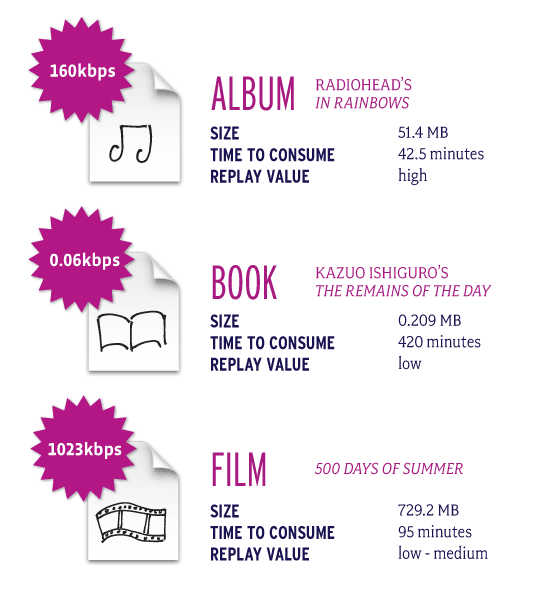(Please, be forewarned: this post is an example of culture geekery at its most insufferably extreme. If you don’t like the idea of Shakespeare being reduced to binary code, STOP. READING. NOW).
So, here’s a weird thought: now that we can reduce photographs, books, films and music to a steady stream of ones and zeroes, it actually becomes possible to place seemingly incomparable formats side-by-side. Is a picture, for example, really worth a thousand words? I’ve just opened up a TextEdit file of a short story I’m working on: saved in plain text it comes to only 8 kilobytes (KB). So, a picture that says a thousand words must come in at around 8KB. With a bit of compression and reduction of dimensions, here’s what I’ve come up with: a photograph I took of a woman buying eggs at a Shanghai city market: 10KB, approx.

Would it take a thousand words to describe, perfectly, what is taking place in this photograph? The roughly equivalent file sizes (between the plain text and the photo) seem to suggest so. Perhaps a picture really does equal a thousand words?
But the difference we notice here is that a picture, when reproduced digitally, is imperfect. If you look real hard at the photograph above, you’ll notice crunchy lines of compression: an algorithm at work designed to make the size of the file smaller by fudging the details. It’s possible, for example, for me to crank up the compression further. The photograph below is real crunchy, and now it’s jammed into only 4KB. That means that it should now be “worth” five hundred words.
There’s an elasticity to digital images and sounds: it will always be possible to purchase a camera which can shoot at a higher resolution, or encode songs in a codec which can squeeze more audial oomph out of every byte. In other words: no matter what you like to tell yourself, your audio-visual media files are doomed to obsolescence.
Words, on the other hand, reproduce perfectly digitally. You can’t “compress” a sentence the same way you can compress an image or a song. Of course, depending on which format you pick (.TXT, EPUB, .PDF, or .AZW), the file size of your digitally-encoded story will differ, but no matter which file format you choose, you’ll still (hopefully) be getting the exact same string of alphabetic characters arranged in the same precise order. Everything else (packaged fonts, better type-setting, cover etc) is gravy – the meat remains the same. It’s possible to convince a person to purchase the same film on Blu-Ray they purchased five years back on DVD (and ten years before that on VHS), because, in an obvious technical sense, they’re “upgrading”. Moving from print to ebook, though, isn’t an “upgrade”. You’re not moving from a low-fidelity reproduction to a high-fidelity reproduction. Actually, you’re moving from perfect-fidelity to perfect-fidelity. It seems too obvious to warrant saying, but if you’ve already purchased Oliver Twist on paperback, you aren’t suddenly going to “see” more in the text by buying the ebook version. This, of course, affects the dynamics of the ebook marketplace: consumers aren’t likely to repurchase titles they already own in order to have them in the latest format.
Here’s something else that’s interesting: films and songs progress automatically, but books don’t. Regardless of whether you’re paying attention to a movie, it will continue to play. Your progress while reading is dependent on how quickly you are able to make sense of the string of words before you. In other words, the fundamental difference between watching a film and reading a book is that in the latter case, you’re in full control of your data “ingestion”. It could take you an hour to read a book, or several days.
If you divide the size of a media file by how long it takes to humanly ingest the data contained, you get a figure of kilobits-per-second (kbps). Most songs, for example, are encoded at 128kbps, which means that you’re ears are processing (on average) 128 kilobits of audio data every second. For music encoded in MP3 or AAC, 128kbps seems to offer a nice tradeoff between quality and file size. Of course, if you’ve got a well-trained ear, anything under 256kbps mightn’t cut it – or, if you’ve got the space, you might decide to push even higher.
In terms of films, most online stores seem to sell at around the 2000kbps range, but I tend to find that around 1000kbps is a pretty acceptable sweet spot if you want to carry your collection around with you on your tablet or mobile device. So, if a picture is – sort of – worth a thousand words, a film gives your brain either ten or twenty times more stuff to focus on at any point in time than a song. And, to make things really interesting, let’s say it takes me 420 minutes to make my way through a reasonably-sized book (that’s possible a fairly glacial pace, so take that into consideration): that’s close to 0.06kbps. That means that a song is over 2000 times “stronger”, in terms of raw data-per-second, than an average book (when read at my snail’s pace).
Is any of this important? Perhaps. Honestly, it’s both terrifying and extremely exciting that we’ve reached this point: where our entire cultural heritage (well, almost) can be reduced to a stream of chunks of noughts and zeros, stretching on and on toward something like infinity.


Comments
3 responses to “1 Picture = ? Words: Quantifying Culture”
Really loved this post. Very interesting to think about.
Thanks Natasha! (PS: Don’t judge, but I’ve been known to indulge in marathons of both The Big Bang Theory and Two and a Half Men. ISAIDDON’TJUDGE).
Judgements are being reserved.
I’m planning on sticking with Big Bang Theory. I’ve been told it gets better..
But Two and a Half Men? My lips are sealed…